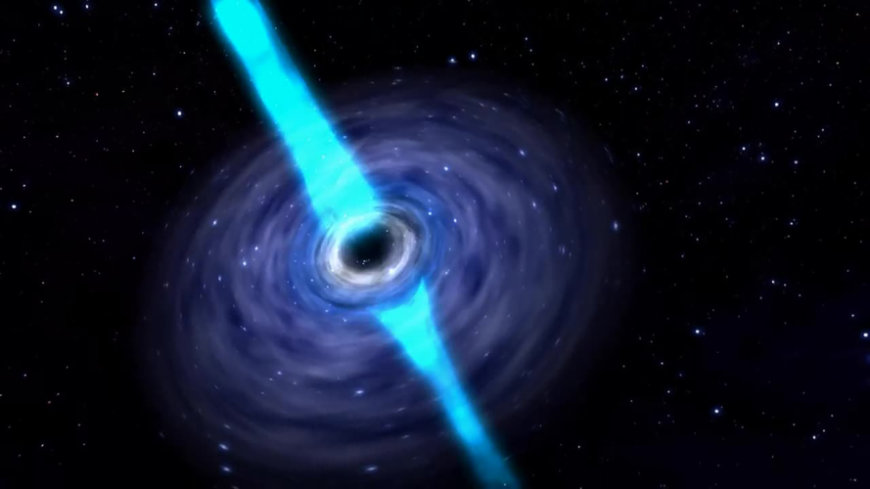Formation of an element around neutron stars
The heaviest elements in the universe arise from extreme processes such as collisions of neutron stars or supernova explosions. It is not yet understood exactly how elements such as gold or uranium are formed. New simulations now show that accretion disks around colliding neutron stars could play an important role.
|
Artistic representation of a hot, dense accretion disk around a black hole, which could be a rich site for producing heavy elements. [Groansicht] |
How are chemical elements produced in our universe? Where do heavy elements like gold or uranium in particular come from? With the help of computer simulations, a research team from the GSI Helmholtz Center for Heavy Ion Research in Darmstadt, along with colleagues from Belgium and Japan, have shown that the synthesis of heavy elements is typical for some so-called accretion disks – these are disk-shaped accumulations of material surrounding holes black . The expected frequency distribution of the formed elements provides information about the heavy elements that will be used in future laboratories such as those under construction Facility for Proton and Ion Research FAIR must be investigated in order to unravel the origin of the heavy elements.
All the heavy elements found on Earth today were formed under extreme conditions in astrophysical environments: inside stars, in stellar explosions, and during collisions of neutron stars. Researchers are busy asking which of these astrophysical events provide the right conditions for the formation of heavier elements such as gold or uranium.
The startling first observation of gravitational waves and electromagnetic radiation from a neutron star merger in 2017 indicated that many heavy elements could be created and released in these cosmic collisions. The question remains, however, when and why the materials are disposed of and whether there are other events in which heavy items could be produced.
Promising candidates for the production of heavy elements are black holes, which are surrounded by an accretion disk made of dense, hot matter. Such a system arises after the merger of two massive neutron stars and during the so-called implosion, and the subsequent collapse of a rotating star. The internal structure of these accretion disks is largely poorly understood, especially with regard to the conditions under which an excess of neutrons is formed. The large number of neutrons is a prerequisite for the synthesis of heavy elements, as it allows rapid neutron capture (rapid neutron capture or r process).
Nearly massless neutrinos play a major role here, as they enable the conversion between protons and neutrons: “In our study we systematically examined the conversion rates of neutrons and protons for a large number of disk configurations using complex computer simulations and found that the disks are very rich in neutrons as long as certain conditions are met,” Dr. explains. Oliver Just is from the GSI Research Division’s “Relativistic Astrophysics” group, “Theory”.
“What matters is the total mass of the disk. The higher the mass of the disk, the more often neutrons are formed from protons by capturing electrons and emitting neutrinos, and therefore they are available for the synthesis of heavy elements using the r process. The mass of the disk is very high, and the opposite happens for the interaction increasing role, ie that neutrinos pick up more neutrinos again before they leave the disk. These neutrons are converted back into protons, hindering the r process,” he just continued.
As the study showed, the optimum disk mass for high production of heavy elements is about 0.01 to 0.1 solar masses. The result provides a strong indication that merging neutron stars that produce accretion disks with precisely these masses could be the origin of a large proportion of the heavy elements. However, it is still not clear whether and how often accumulation discs occur in systems of failure.
In addition to the possible mass ejaculation processes, the research group on special lecturer Dr. Andreas Bauswein also searches for light signals generated by emitted matter, from which one would like to infer the mass and composition of emitted matter in future observations of neutron star collisions. An important component of the correct reading of these light signals is an accurate knowledge of the masses and other properties of the newly formed elements.
“These data are currently insufficient. But with the next generation of accelerators, for example with FAIR, it will be possible to measure it with unprecedented accuracy in the future. In the next few years, it will make it possible to test neutron star mergers and the origin of the elements of the process r “, predicts Bauswein .
The results of the research were published in the journal Monthly Notices of the Royal Astronomical Society Posted.
|
|
|
|
|
|

“Social media evangelist. Baconaholic. Devoted reader. Twitter scholar. Avid coffee trailblazer.”









